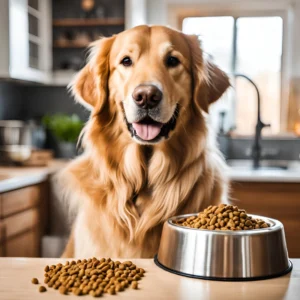Table of contents
Start with an Intriguing Question

Have you ever wondered if the food you’re feeding your dog is truly meeting all their nutritional needs? Many pet owners are turning to homemade meals for their furry friends, and it’s no surprise why. With vet approved homemade dog food recipes, you can ensure your pup gets the best care possible while enjoying delicious, healthy meals.
Overview
What makes these vet approved homemade dog food recipes so special? They’re crafted with love and science in mind, ensuring every bite delivers balanced nutrition tailored to your dog’s unique needs. These recipes don’t just satisfy hunger—they support overall health, from shiny coats to strong bones. Plus, most of them take less than an hour to prepare, making them perfect even for busy pet parents.
Time Requirement
- Prep Time: Approximately 20–30 minutes per recipe.
- Cook Time: Around 30–45 minutes depending on the dish.
- Total Time: Under an hour for most recipes.
Difficulty Level
These recipes range from beginner-friendly to slightly advanced, but don’t worry—each one comes with clear instructions to guide you step by step.
Essential Ingredients
Here’s a list of key ingredients you’ll need for these vet approved homemade dog food recipes, along with explanations of why they matter:
- Protein Sources: Chicken, turkey, beef, or fish provide essential amino acids that build muscle and maintain energy levels.
- Carbohydrates: Rice, sweet potatoes, or quinoa offer slow-release energy and fiber to keep your dog feeling full longer.
- Vegetables: Carrots, spinach, and green beans add vitamins, minerals, and antioxidants that boost immunity.
- Healthy Fats: Coconut oil or olive oil supports skin and coat health while aiding digestion.
- Herbs & Spices: Parsley, turmeric, and ginger have anti-inflammatory properties that promote long-term wellness.
Substitutions and Variations
Feel free to swap out ingredients based on your dog’s preferences or dietary restrictions. For example:
- Use lamb instead of chicken for dogs with poultry sensitivities.
- Replace rice with barley for added fiber.
- Add pumpkin puree for extra hydration and digestive support.
Step-by-Step Instructions
Let’s dive into how to prepare one of our top recipes: Chicken and Sweet Potato Stew.
Ingredients:
- 1 lb boneless, skinless chicken breast
- 2 medium sweet potatoes, peeled and diced
- 1 cup brown rice
- 1 carrot, chopped
- 1 tbsp coconut oil
- Water as needed
Steps:
- Prepare Ingredients: Wash and chop all vegetables into small pieces. Cut the chicken into bite-sized chunks.
- Cook Proteins First: Heat coconut oil in a large pot over medium heat. Add chicken and cook until fully cooked through, breaking it apart as it cooks.
- Add Vegetables: Once the chicken is done, toss in the sweet potatoes, carrots, and rice. Stir well to combine.
- Simmer Until Tender: Pour enough water into the pot to cover the ingredients. Bring to a boil, then reduce heat and let simmer for about 25 minutes, or until everything is tender.
- Cool Before Serving: Allow the stew to cool completely before serving to avoid burns.
Tips for Cooking Techniques:
- Always use fresh, high-quality ingredients to maximize flavor and nutrition.
- Cook proteins thoroughly to prevent foodborne illnesses.
- Store leftovers properly to extend shelf life (more on this later).
Assembly
Now that you’ve prepared the base, here’s how to assemble and present your dog’s meal:
- Portion Control: Divide the stew evenly into bowls according to your dog’s size and caloric needs.
- Add Toppings: Sprinkle some crushed kibble or a dollop of plain yogurt for added texture and probiotics.
- Presentation Matters: Arrange the food neatly in the bowl—it might not matter to your dog, but it’ll make mealtime more enjoyable for you!
Presentation Tips:
- Use colorful veggies like bell peppers or peas to brighten up the dish.
- Serve warm for a comforting touch during colder months.
Storage and Make-Ahead Tips
Proper storage ensures your homemade dog food stays fresh and safe for consumption.
How to Store:
- Refrigerate cooked portions in airtight containers for up to five days.
- Freeze larger batches in individual servings for up to three months.
Reheating Tips:
- Thaw frozen meals overnight in the fridge before reheating.
- Warm gently in the microwave or on the stovetop with a splash of water to retain moisture.
Recipe Variations
Variety keeps things exciting! Here are six additional vet approved homemade dog food recipes to try:
- Vegan Dog Bowl: Made with chickpeas, lentils, and mixed veggies, this plant-based option is great for dogs with allergies.
- Turkey Meatballs: Ground turkey mixed with oats and eggs makes for a protein-packed treat.
- Salmon and Quinoa Delight: Rich in omega-3 fatty acids, this recipe promotes heart and brain health.
- Beef and Broccoli Feast: A hearty combination perfect for active breeds.
- Pumpkin and Chicken Casserole: Perfect for sensitive stomachs, featuring gentle pumpkin and lean chicken.
- Lamb and Lentil Stew: Ideal for dogs who thrive on red meat diets.
Conclusion
Homemade dog food doesn’t have to be complicated or time-consuming. By following these vet approved homemade dog food recipes, you can give your furry friend the gift of wholesome, nutritious meals. Remember, cooking for your dog is not only rewarding but also a way to bond and show love. Don’t hesitate to experiment with flavors and textures—your pup will thank you!
FAQs
Q: Can I feed my dog homemade food every day?
A: Absolutely! As long as the recipes are nutritionally balanced and meet your dog’s specific needs, homemade food can be a daily staple. Consult with your veterinarian to tailor recipes to your dog’s age, weight, and activity level.
Q: Are there any foods I should avoid when making homemade dog food?
A: Yes, certain human foods are toxic to dogs, including chocolate, grapes, onions, garlic, and avocados. Stick to safe ingredients listed in vet approved recipes to keep your dog healthy.
Q: How do I transition my dog to homemade food?
A: Gradually mix increasing amounts of homemade food with their current diet over seven to ten days. This helps prevent digestive upset and allows your dog to adjust slowly.
Q: What are the health benefits of homemade dog food?
A: Homemade meals often contain fresher, higher-quality ingredients than commercial kibble. They can improve digestion, enhance coat shine, boost energy levels, and cater to specific dietary requirements.
By mastering these simple yet effective vet approved homemade dog food recipes, you’re giving your beloved companion the ultimate gift of health and happiness. Happy cooking—and happy eating!

